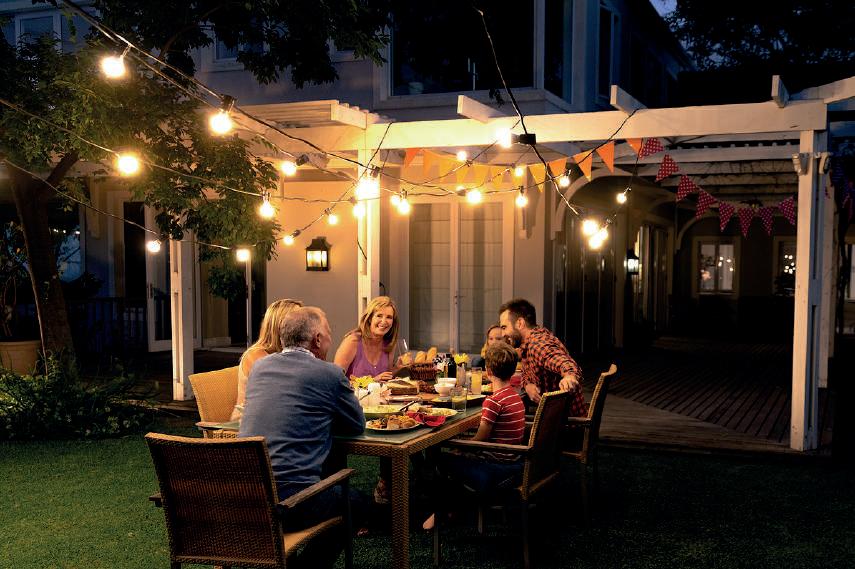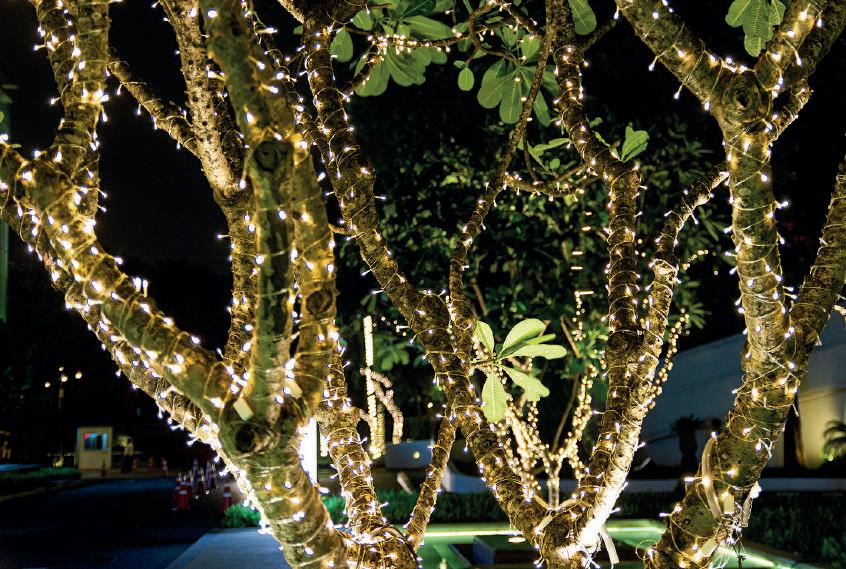
22 minute read
Garden
Interveinal Chlorosis Caroline has been a lecturer in horticulture for 20 years and is now running a nursery and 'garden craft' courses in the Haute-Vienne

Advertisement
By Caroline Wright
Blossom end rot

Camellia plants love acid soil and suffer without it
garden Drunk and Disorderly
PLANT DISORDERS ARE PLANT MALADIES CAUSED BY ENVIRONMENTAL FACTORS RATHER THAN PEST ATTACK (INSECTS, BIRDS, MOLLUSCS ETC) OR DISEASES WHICH ARE GENERALLY CAUSED BY VARIOUS PATHOGENIC FUNGI AND SOMETIMES BACTERIA.
The most common disorders are caused very dry soils the calcium simply cannot by nutrient deficiencies. This is where be taken up. the plant cannot grow properly due to a lack of one or more essential nutrients, just like we might suffer from a lack of The answer is to test the pH of your soil to see whether you need to add any calcium (in the form of ground limestone or certain nutrients in our diet; a severe lack calcified seaweed) and make sure that of vitamin C for example causes scurvy, your tomatoes are watered evenly and and a lack of calcium impacts on the regularly, and mulch them to prevent all formation of our teeth and bones. of the moisture from evaporating from Sometimes a deficiency disorder in plants the soil. is caused by poor soil that lacks the actual Calcium deficiency also causes ‘bitter pit’ mineral nutrients themselves, sometimes in apples and pears, where there are tiny it is due to reactions between the different hard points within the flesh and the fruit nutrients in the soil creating bonds that doesn’t swell properly, and it can cause ‘tip effectively ‘lock them up’, making them burn’, the browning and shrivelling of the unavailable to the plants. At other times it edges of lettuce leaves. can be due to a lack of water – most of the soil borne minerals required by plants are taken up dissolved in water just as we drink mineral water. In times of drought this can be very common and is especially noticeable on fast growing plants that Tomatoes suffer from several nutrient disorders due to their high demand on nutrition. Nitrogen is another nutrient needed in large quantities while the plant is in active growth. When nitrogen gets scarce that plant actually takes it from the require a lot of nutrients while growing. lower leaves and moves it up to the Tomatoes and many other vegetables are growing points of the plant causing the examples of this lower leaves to yellow and and our veggie crops are easily affected. If you have chalky or lime rich soil then avoid the eventually die off. This in itself is not too terrible as there is naturally some loss There are over 14 plants that hate lime of the lower leaves and we different minerals that plants need to access from the soil, but 2 or 3 of them are the most commonly problematic. can take off any damaged and sickly lower leaves without doing too much harm to the plant, but an ongoing lack of nitrogen will cause the plants to become stunted, yellow and Plants require calcium as one of the key weak and susceptible to other pests materials for building the cell walls, and diseases. therefore without calcium they cannot build new growth properly. There are several ways that calcium can affect the yield and quality of our fruit and veg crops: On the other hand iron deficiency is common on calcium rich (alkaline) soils where the calcium bonds with any iron in the soil and effectively makes it unavailable to the plants. Some plants are Blossom end rot of tomatoes… well adapted to this and can make use of When the base of your tomato is sunken very small amounts of available iron, while and black, this is caused by a calcium others suffer from iron deficiency – these deficiency (it affects peppers and plants are commonly known as ‘acid aubergines too). This is most often seen in loving’ plants, ericaceous plants or tomatoes grown in pots where the calcifuges. Examples include compost quickly runs out of nutrient Rhododendron, Azalea, Camellia, some value, or the calcium can easily be washed heathers, blueberries and Pieris. The main away by over watering. In acid soils there symptom of iron deficiency is known as is much less available calcium than in an ‘interveinal chlorosis’ where the leaves go alkaline soil so soils with a low pH have distinctly yellow between the veins and the more tendency to cause this deficiency. In whole plant fails to thrive. The reason for this is that iron is one of the major components of chlorophyll; if the plant is unable to generate sufficient chlorophyll then it first looses its green colour and with that the ability to photosynthesise efficiently and therefore lacks the sugars required for healthy growth. There are several remedies for this, but the first principle is to choose plants that will thrive in your soil and microclimate. So if you have chalky or lime rich soil then avoid the plants that hate lime. If you really want to grow them then you can plant them in containers in an ‘ericaceous’ compost, you can feed them with a special formula that prevents the iron from bonding with other elements in the soil (known as ‘Sequestrate’ or ‘Chelate’ of Iron - Engrais Hortensias is what to look out for here) or you can attempt to change the pH of your soil. Bear in mind that this is an ongoing process that will always be a battle, particularly if you are trying to lower the pH of an alkaline soil to make it more ‘acid’ and it is not recommended. Other deficiencies that effect your veg include ‘Riciness’ of cauliflower where the head develops the look and texture of rice, caused by hot conditions where the head has been induced to develop too quickly, and ‘Measles' on smooth skinned melons and cucumbers where excess salts accumulate in the skin causing dark spots to appear, usually as a result of overly wet soils in the latter stages of growth - careful attention to watering is required to prevent this.

Le Jardin Créatif offers a range consultancy and design services to help you develop, maintain and solve gardening problems. Send us an email lejardincreatif87@gmail.com or check out our ‘Consultancy and Garden Design’ page for more information. Our courses are up and running again and we have our updated plant list available to browse on the ‘Nursery and Garden’ web page. We will have a range of heirloom apple tree varieties available from September.


Light Up Your
NOT HAVING ANY KIND OF LIGHTING IN THE GARDEN IS LIKE HAVING A SITTING ROOM WITH NO LIGHTING – UNUSABLE WHEN IT’S DARK!
Lighting is a very important factor to consider when planning the hard landscaping of your garden and the obvious time to do the preparatory work for your garden lighting is at the initial landscaping stage when earth moving is being carried out. Even subtle lighting in the garden such as the use of candles will extend the hours that a garden can be enjoyed. There are 3 main ways to provide lighting for the garden - electric, solar/battery operated, and candle. Electric Lights Cables for electric lights need to be buried in armoured cable and we would recommend that a registered electrician is always used to install the electrics for garden lighting, particularly when using mains voltage (240 volts). Kits are available for garden lighting which use 12 volts which can be installed by a person competent in DIY. When using a 240 volt system, a transformer converts mains voltage to 12 volts. Even low-wattage lights should still be plugged into a circuit breaker which cuts the power at once and so prevents shocks if the cable accidentally gets cut. When planning a lot of garden electrics such as lighting, pond/pool pumps and water features, it may be worth considering having an outdoor electricity supply created which is basically a box into which outdoor-grade plugs can be plugged. The lid of the box seals around the sockets to prevent any moisture entering.
Action this summer and we’re really pleased with the amount of light they produce, proving that lighting up the garden doesn’t need to be expensive. The most important thing to consider Candles when choosing lights for the garden is to ensure they are specially constructed for outdoor use. They must be waterproof, resistant to corrosion and able to withstand frost, snow and damp. Most garden lights therefore are constructed from aluminium alloy or high impact plastic. There are many different styles of electric lights available so it shouldn’t be too difficult finding lighting suitable for both your style and budget. Candles provide a soft, romantic glow and many types of lanterns and outdoor candle holders are available. Outdoor candles need some kind of protective cover around them otherwise even a gentle breeze will blow them out. Interesting holders can be created from old tin cans: wash a used can (ensuring the sharp edges have first been removed) then use a special tool to punch holes in patterns in the can. This can be painted with fire-retardant paint The use of candles will extend the hours that a garden can be enjoyed Solar/Battery Lights and a handle created by This kind of lighting has traditionally offered inferior lighting but is able to provide lighting in the garden when a power source is unavailable. There are some excellent solar lights on the drilling 2 holes into the open end of the can and threading wire through them. Candle holders don’t come much cheaper than this and you are helping the environment by recycling. market now but the good quality ones are Creating Specific Effects from quite pricey if you want to invest in good Garden Lighting. quality solar lights. However, if you are happy with something which lasts maybe Security Lighting just one season then these are readily This is often the harshest of all types of available from budget shops such as garden lighting but unlike other forms of Action or GiFi. Concerning battery garden lighting it is not intended to create operated lights, we bought some pretty ambiance but rather to throw lots of light glass ones for around a fiver each from for a specific purpose. Security lighting


Landscape
can be used with an automatic sensor to lighting can be used to great effect to light deter intruders who approach the house or feature trees and plants, especially where may be installed for example close to a they are planted against a wall and can front door to allow the homeowner to be cast exciting shadows. Alternatively, they able to easily enter the house without can be set into wooden decking to fumbling for keys in the dark or stumbling effectively light containers with over planters. Be aware of using too much architectural forms. of this type of lighting as the sensors can easily be activated by passing moths etc Downlighting/Floodlighting causing the lights to be continually This is quite a difficult style of lighting to switched on and off. This is irritating at use as it can have an overpowering effect. the very least but can also be disturbing to It should mainly be used therefore in local wildlife (and possibly neighbours). functional areas to illuminate large areas Security lighting however does not need to be so harsh. The use of a low voltage light will work equally well to guide you to your front door and has the in a pool of light– eating and cooking areas for example. Using a down light in the centre of a pergola used as a dining area can be very effective. This is a technique which imitates the natural light from the moon advantage of being able to It can however be used be left on whilst you are out without to create some fun effects such as fixing dazzling your neighbours or ramping up coloured lights just below the canopies of your electricity bills. several trees in the garden to create a Up lighting surreal retro club feel. They can also be used to accentuate bold architectural Lighting the garden by ground-level shapes of both buildings and plants. lighting creates an energetic feel and is the exact opposite of sunlight which lights the Moonlighting garden from above. One thing to be aware This is a technique which imitates the of with this type of lighting is that it can natural light from the moon and so needs have the effect of drawing the eye to the to be quite a soft light. This is achieved by actual light itself rather than the object to placing a light high into the branches of a be illuminated so try to avoid using lights tree and directed downwards to create a with a very powerful wattage. This type of dappled effect of light and shadow.
Tracy & Lorne Taylor-Made Gardens
Grazing This lighting technique is achieved by throwing light at an angle onto a hard surface such as a wall and works even better on a textured surface such as woven fence panels as it enhances the texture and so renders the lit area more interesting at night than in daylight. Backlighting This is also known as silhouetting and is created when the background behind an interesting or semi-transparent structure is highlighted instead of the structure itself which remains in darkness but creates a silhouette. It is good for creating interesting outlines. Shadowing This technique is achieved by shining a light at an object so that its shadow is thrown against a vertical surface such as a wall or fence. It is a great technique for highlighting plants such as grasses or bamboos as a gentle breeze will create a marvellous moving effect of shadows. With this technique it is good to experiment by moving the light closer to or further from the subject to alter the size of the shadows. Route lighting This type of lighting can be achieved by using either low-level lights or lights on
bollards. Placing lights on bollards is an excellent way to light a driveway for example whereas low-level lights are good for highlighting paths. Using this technique can also be used to create pathways which are not visible during daylight by sinking lights into a lawn. Route lighting is invaluable when used where there are steps in the garden. Lighting individual steps is an excellent way to prevent accidents but can also be a stylish addition to your garden lighting. Treelights/Fairy Lights This type of opaque lighting casts soft shades. Fairy lights create a romantic feel to an area of a garden when they are strung within the canopy of a tree or from a pergola to mimic tiny stars. Clear lights look more subtle and contemporary whereas coloured lights will give more of a party feel. Lamps may also be suspended from a tree to create an intimate dining area. Coloured Lighting This is not an easy technique to use as it can look quite tacky. If you know what you are doing however, it can also look stunning. For example, a lawn flooded with green light will give an artificially green colour to the grass although it can look quite surreal. Fibre-optic Lighting This is used ornamentally as it does not produce a huge amount of light. It usually consists of a single light source passing down a group of filaments of optical glass or plastic and creates a mass of twinkling pinpoints of light. It is a good technique to use around water either to highlight a pool sculpture or to use within moving water where they will a stunning glittery effect. To get a feel for what can be achieved with fibre optic lighting, check out the following website - plantnj.com/fiber-opticswimming-pool-lights-landscape-nightlighting-LED-pool-lights.php Try not to get too excited though – the price of this kind of lighting is way beyond the reach of most of us mere mortals without the aid of a significant lottery win! Lighting Water Water and lighting together provide a wonderful and interesting element to the garden. Underwater lighting in ponds, pools and fountains can be stunning and atmospheric, as can lighting up features such as bridges or decks close to water. Mirroring is a dramatic effect using a combination of up lighting with still water. Up lighting structures, planters or buildings around a pool will create an amazing mirrored effect on the surface of the water. The final part in this series of articles next month will conclude with an article on decorating your garden.
Advertise Your Business

For as little as 35€ ttc
www.etceteraonline.org
New Wood Trees

www.newwoodtrees.com
qualified. Fully insured
Covering Haute-Vienne, Charente and North Dordogne
Read our story & approach… www.facebook.com/Newwoodtrees
Siret: 84319416800012
TEL: 06 04 44 34 11 EMAIL: jscclegg@gmail.com
siret51325382300019
siret: 452 821 101 00022
TREE SURGEON

● Fully insured and registered ● Free quotes and advice ● From pruning to dismantles ● Overgrown hedges
Call Darren Shepherd www.viennetreeservices.com 05 49 87 29 16 / 06 73 21 00 27
David Cropper

Stump Grinding Service
I grind tree & hedge stumps away leaving no trace Less mess than a digger, quicker than burning and will not break the bank 05 17 34 14 37 / 06 02 30 66 69 stumpgrindingcharente@gmail.com www.stumpgrindingcharente.org based in 86 nr Montmorillon
From Pruning to Dismantling Call Stephen on 05 49 91 63 60
Email latuilerie@live.fr
~ M&M ~ Stump Grinding Services
Siret 82184631800011
For more information and a quote
Cotswold Eco Wood Fired Hot Tubs

Siret 879 912 855 0019
Perfect for any garden space HOT TUBS in France Step into your own paradise to relax and unwind www.cotswoldecotubs.co.uk
▪ Comfortable fibre glass seating for 4/5 ▪ Colourful LED lighting

▪ Soothing air bubbles ▪ Steps, drink holder & lid all included in the price.
Eco Hot Tubs can be sited anywhere. If you need assistance we can landscape your garden ready for your new wood fired hot tub
Contact Nicola cabey69@live.co.uk (0044) 784 575 4049
Tim Shepherd
✓ garden care painting fencing ✓ ✓ cleaning caretaking maintenance ✓ ✓ ✓ key-holding admin help changeovers Tel : 05.49.87.02.96 shepherd.timothy@orange.fr Siret 752 049 932 00011
D and M New location Chabanais Gardening Services
Now based near Chabanais, covering surrounding areas
Throughout the seasons
Honest ~ Reliable Professional Over 15 years’ experience
Contact Dan For a free quote & advice danmoore232@gmail.com 06 88 95 33 99 / 05 45 84 16 42
Siret: 825 313 372 00013
GARDENING SERVICES All Aspects of Garden work undertaken Grass Cutting - Hedge Trimming - Fencing - Pruning - Strimming Garden Clearance - Cutting Back Trees - Tidy Ups - Clearing + more!


Tel: Frank Hawkins 05 55 71 43 38 Email: sparksstudio@yahoo.com Facebook: Hawkins Gardening Services Siret: 514 758 028 00013 Areas covered 87 & 24
~ Hedgecutting and paddock mowing ~ Flail mowing for rough/long grass areas ~ All excavations and groundworks undertaken ~ Woodchipper and operator for hire ~ All fencing carried out ~ Patio's, driveways and excavations

Tersannes Timber Tersannes Timber For all your gate and fencing requirements ��� Range of gate designs Highest quality, traditionally available made…. at affordable prices ��� Starting from 135 euros ��� Delivery available ��� Installation possible by local trusted artisans ��� Gates, fencing and fittings always in stock ��� Pressure treated class IV ��� Pay in £s or euros www.gatesinfrance.com Phone: 0555 601418 E-mail: gatesinfrance@live.co.uk
Two ladies VAN

Garden Waste

Barns Cleared Unoccupied holiday homes checked in the North Charente, Vienne and Deux-Sevres
For enquiries or rates please contact us on: 0772 388 460 or 0963 681 249 Siret registered
Siret: 812 629 673 00011
Property Maintenance Services Web: www.yourlocalhandyman.eu Email: info@yourlocalhandyman.eu Tel: 05 45 30 73 88
DALLE-87 JUST SLAB IT
Visit our website: www.dalle-87.com Planning a new terrace or patio? Then view our range of slabs, borders and copings. With expert help and advice at hand we can offer a complete design, delivery and installation service. 06 38 55 49 88

FENCING
• Agricultural/Equestrian • Garden • Swimming Pool GATES • 5-Bar Field/Entrance 32 years’ experience Free estimates • Garden • Driveway
Neil: 05 55 00 08 90 / Mob: 06 11 71 66 87

By Ronnie Ogier
Ronnie is a passionate gardener and now loves sharing her years of experience of success and failures in her own garden and sharing it with you. Also a keen runner, having been bitten by the ‘Couch to 5K’ bug!
JOBS TO DO IN THE GARDEN
FINALLY - THERE IS A FRESHNESS IN THE AIR!
The days begin to shorten, and the sun the flowers and clearly label each plant, loses some of its intense heat and our then when you lift the plant you keep the gardens recover some of their earlier label with it. Towards the end of the seasonal freshness. There is still time to sit month cut back and tie in climbing and for a while and enjoy your garden but rambling roses to reduce wind damage there are other things to do at this time of during the winter. And if you wish to year. Keep removing weeds to prevent extend your rose collection, take seeds setting that will come up next year. hardwood rose cuttings from nonThere's not as much to do in the flowering stems. ornamental garden, except the ongoing deadheading to encourage your plants to give to the very end, but if you have a fruit or vegetable patch, you'll be busy reaping the rewards of harvest! Make the most of the remaining warmth while you can! Finally, to add some colour during the winter months, replace your summer bedding with winter/spring bedding plants. It is now time to plant bulbs in pots for winter colour in the house. There are many plants you can try; my favourites are In the flower garden hyacinths for their perfume and amaryllis Start thinking about your garden for next for their vibrant colours. year, as it's time to start planting springIn the vegetable garden flowering bulbs. If your herbaceous perennials are looking a bit tired it’s a good time either to lift and divide, replanting or potting up divisions; or to buy and plant new perennials; or take cuttings of the ones you have and grow them on over the winter inside, to plant out in the spring. It’s also a good time to collect or buy seeds for both perennials and hardy annuals to plant for a good start in the spring. There is still, and probably always will be, work to do in your potager. Keep an eye on all your crops as the last ones come to full maturity, enjoy your last cucumbers, courgettes, aubergines and chillies, and harvest your pumpkins and winter squashes. Continue to take the leaves off tomato plants so that the sun can ripen the last fruits. You can still plant out crops to take you through the winter – cabbage, spinach and winter lettuce seedlings to complement the winter vegetables such as You can still plant out crops to take you through the winter Now is also the time to start thinking sprouts and broccoli that should already about the coming winter and making early be growing well. It is also worth preparations. If you intend to lift and store experimenting with potatoes – plant in the dahlias and cannas it is wise to find the usual way and cover with a thick mulch for names of them now while you can still see a very early spring crop.
Looking after your lawn
My lawn is now a very brown patch with lots of clover. For me it’s time to forget my English green sward and accept that in my area of France lawns rarely survive the summer heat without a considerable amount of water! But I know it will come back when the temperatures fall and we get a bit of moisture, even the dew in the mornings helps to start the recovery. Either when it regrows, or you are lucky enough to have been able to maintain some grass, later in the month is the time to scarify to aerate the ground, then feed the lawn and let the autumn and winter rains do the rest. If you are starting afresh with a new lawn now is a very good time either to plant seed or lay turf, after the appropriate work on the ground. You can also take the opportunity to brighten up your spring lawn by planting spring bulbs such as crocus, anemones and snowdrops. If you look through the bulb catalogues you will also find some less common bulbs that can be planted in grass such as the Russian Snowdrop (pushkinis libanotica) or some of the smaller fritillaries. Take time this month to walk round the garden and look at your plants. Decide what you want to change and use any photographs you have taken to help your decision; autumn is a good time to move most plants while the ground is still warm. Enjoy planning for next year, looking at catalogues and ordering seeds and plants.










